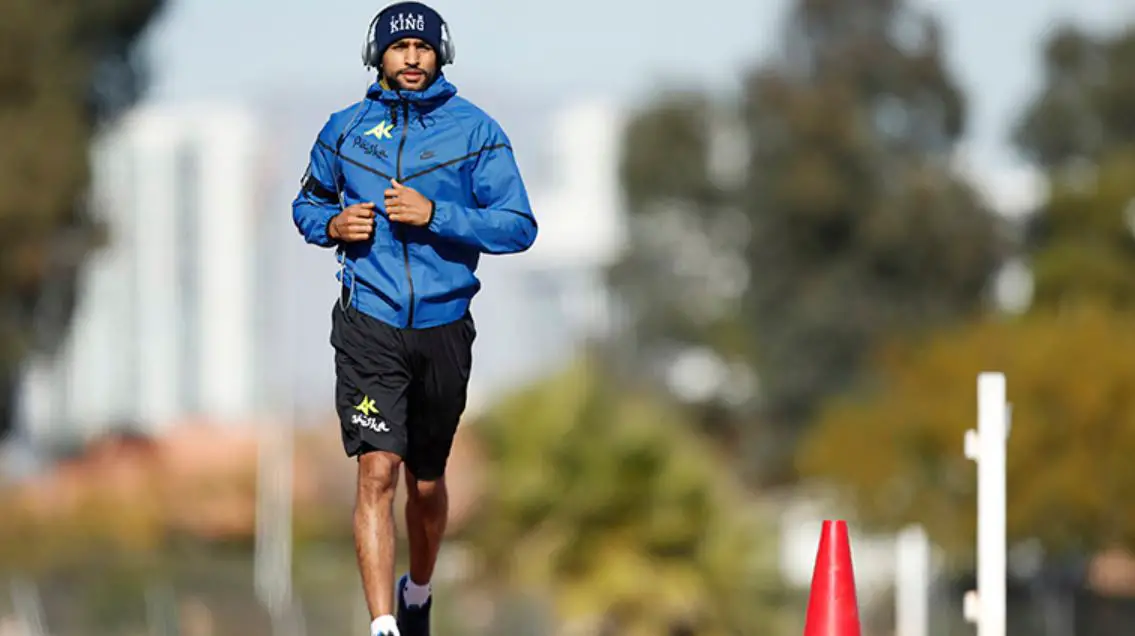
When you look at the amazing physique of modern day fighters, it is only natural to wonder whether they train everyday or not and how much of that training involves cardio
When I trained as a professional fighter, it was 7 days a week with no days off, all of the time.
That being said, a lot of fighters see the benefits of rest and may take Sundays off or every second Sunday to let their body fully recover.
Boxing Training is all heavily cardio based, whether that is traditional forms of cardio like running, skipping, cycling and swimming or boxing cardio like hitting the bags, hitting the pads or sparring. Most Pro boxers will train twice a day when getting ready for a fight including a run in the morning and a boxing related session later in the day.
How Much Cardio Will A Pro Boxer Do In A Week
Almost all training for boxing can be classed as cardio, whether that is cardio only or boxing-style cardio it is all going to build up the aerobic system to an extent.
Training For A Fighter With 8 Weeks To Go To A Fight
Exercise |
Times Per Week |
| 6 Mile Run | 5 Times |
| 15 Mile Cycle (Possible) | 1 Time |
| Swimming Workout (Possible) | 1 Time |
| Skipping (10 Minutes – No Break) | 6 Times |
| Rowing (10 Minutes – No Break) | 3 Times |
| Sprints | 1-2 Times |
| Conditioning Circuits | 3 Times |
| Bag Work | 6 Times |
| Pad Work | 6 Times |
| Sparring | 2 – 3 Times |
Before we go any further, it is important to note why there is such an emphasis on cardio for boxing and to get a full understanding of this we need to have a look at the bodies 3 energy systems and how they translate into Boxing Fitness.
The Bodies Energy Systems

The body is made up of 3 separate energy systems: The Aerobic, Anaerobic and The Alactic System.
The Aerobic System:
The Aerobic system is like the size of the engine in the car.
It is built up using long-duration, steady state cardio like jogging or cycling.
In Aerobic Exercise, the body is able to continually fuel itself with oxygen.
Aerobic exercise can last from about 3 minutes to many hours.
It determines how many rounds a fighter can stay fresh for.
The Anaerobic System:
This is more intense exercise where the body can not fully refuel itself with oxygen and needs to take a break.
It is like throwing a 12 punch combo in a fight and then having to circle around to recover.
The Anaerobic system is built on the foundation of a solid Aerobic system which can last for years once built up.
Have a strong Aerobic system allows fighters to throw combos and recover quickly, even in the later rounds.
The Alactic System
The body one rep max, this is when a fighter throws a single punch looking for the knockout.
He puts all of his power into to shot and then needs to recover quickly.
This is again built on the foundation laid by the Aerobic and Anaerobic bases.
It can be built up with high intensity exercises like strength training with weights.
You can think of the systems like in the old boxing games

- One Bar Goes Down Slowly Over The Rounds: The Aerobic System
- One Bar Goes Down Quickly In Direct Correlation To The Punches You Throw: The Anaerobic System.
The Importance Of Cardio And Building The Aerobic System
Building the Anaerobic system for boxing is easy, it is just hitting the bags, hitting the pads, sparring, skipping, rowing, doing circuits and just boxing training in general.
The problem is that you can’t really build the Aerobic system as much as you would like in the boxing gym which is one of the reasons why boxers run so often.
We need to understand that the Aerobic and Anaerobic system is like a scale. The more intense it is, the more it is Anaerobic but it still has some element of Aerobic in it as well.
Best Ways For Boxers To Build A Solid Aerobic System
Running
The further out from a fight that you are, the better it is going to be to work on the Aerobic system.
Once you build it up, it will last for years to come.
If you don’t have a fight for months to come, you can run slowly for 7 – 10 miles to really build up the base.
The closer you get to the fight, the more you should be looking at shorter, faster paced runs to simulate a fight.
Running is crucially important for boxing, which is why fighters like Floyd Mayweather ran 6 miles a day while he was fighting.
A lot of new school trainings think running is useless for boxing. This is absolute nonsense.
Do you want to trust Floyd Mayweather or some bodybuilder who probably couldn’t last 3 rounds?
The are plenty of other benefits to running for Boxing, including conditioning the legs and making a fighter lighter on his toes.
Building the Aerobic base is the most important however.
Cycling
Cycling is becoming more and more popular with boxers as it has less impact on the knees and is also great for increasing leg strength and it is also quite enjoyable.
I would say that running is a lot better for the sport of boxing, but there is nothing wrong with throwing in a cycle or two during the week as well.
To build the aerobic base, you should be talking about at least 15 miles.
Swimming
Swimming is another excellent exercise for boxing, that doesn’t have any impact on the knees.
It is slightly more Anaerobic but is still super effective for building the aerobic system.
Swimming also works every muscle in the body, is great for recovery after a tough session and also helps a fighter to focus on his breathing.
Skipping
Skipping is another very important exercise for boxers and it helps to build up the Aerobic and Anaerobic conditioning system.
If you want to work the Aerobic system with Skipping, the slower you should go and the longer your rounds should be.
The faster, more intense and shorter rounds will target the Anaerobic system more.
Skipping is great for conditioning the legs, helping a fighter to stay light on his feet, improving footwork and most importantly, increasing the coordination between the arms and the legs that is so important for boxing.
Rowing Machine
The Rowing machine is good intense exercise that targets both the Aerobic and anaerobic system.
A good 10 minute session on the rower without a break will build up the shoulders, biceps, back and increase a fighters stamina to get them ready for a fight.
The more different variations we can hit our aerobic system with, the better prepared we will be for anything that comes at us in the ring.
Bag Work
Bag work is definitely moving towards the Anaerobic system but it still definitely has an element of aerobic or cardio to it.
While it’s not strictly cardio, it is crucial for building up the body for hard 3 minute rounds, throwing continuous punches.
Boxers can choose to work on movement and timing (Aerobic), Throwing combinations and working at a fast pace (Anaerobic) or throwing heavy shots looking for the knockout (Alactic).
They can also mix up each round with all three or alternate between rounds.
Pad Work
Pad work is the way a trainer will develop the boxer into a better all around fighter.
They will work on offense, defence, footwork as well as the fighters strengths and weaknesses.
Pad Work is also the way a trainer and fighter rehearse a game plan for any upcoming fights.
Pad work is great for improvement but is also excellent cardio.
It simulates a real fight in that pad work can last for a number of rounds, building the aerobic system and it also involves tons of combinations to work the anaerobic system.
Pad Work is one of the most important ways a fighter can get ready for a fight and improve in general.
Sparring

Sparring is the ultimate test of how well you have conditioned yourself for a fight.
There is no feeling quite like going into a sparring session and getting tired after 30 seconds.
Your arms fill with acid and you are struggling for breath. It doesn’t really matter who well you can box once you get tired and that’s why boxers place so much emphasis on cardio when they are getting ready for their fights.
Sparring is the ultimate test of whether you are ready for a fight in terms of cardio and skills.
Sparring can often last 12 rounds to simulate a real fight and the opponent will often be replaced by a fresh sparring partner every couple of rounds when a pro is getting ready for a big fight.
Conclusion
With the exception of some boxers who take Sundays off or dedicate it to strength training, most fighters will absolutely train cardio everyday.
It is crucial to boxer for staying fresh for the entire fight and for recovering quickly after intense flurries.
We hope you enjoyed our article and see you on the next one.
